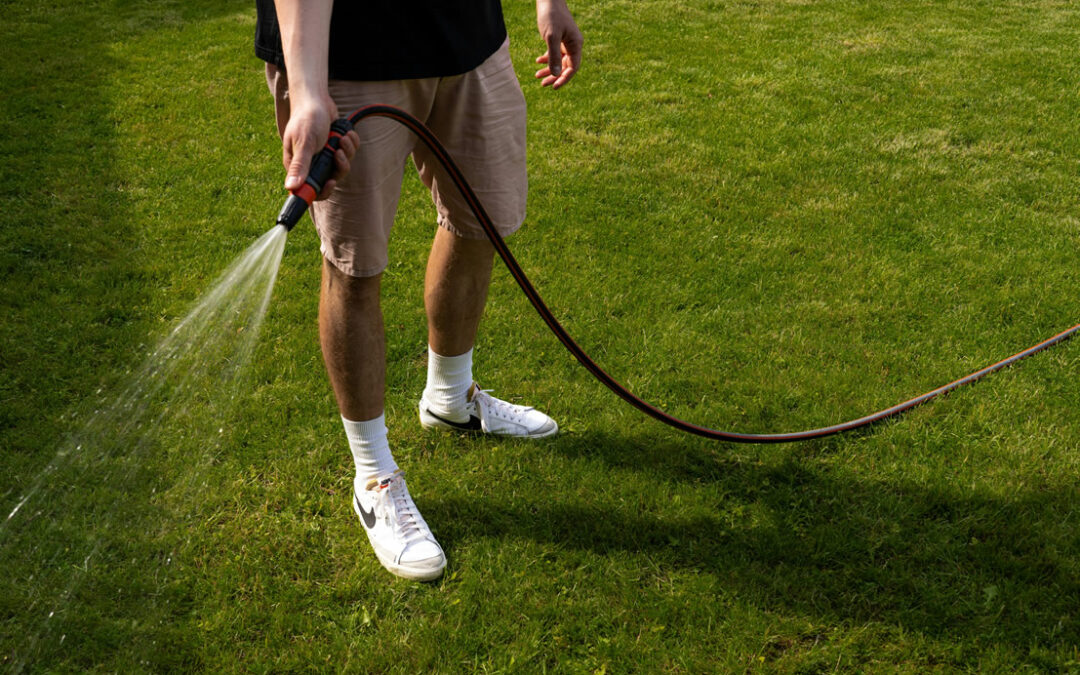Eco-friendly lawn care does more than reduce your carbon footprint while keeping your lawn in great condition — it’s also essential if you want to keep your lawn from falling victim to the summer heat, especially with limited water availability.
Lawn care can cause your water bill to skyrocket, so many homeowners are in search of ways to conserve water. For some, lawn care is one of the first things to be on the chopping board when trying to conserve water.
Does lawn care really need to take a backseat during the summer? We at MowTown Blades say no.
These eco-friendly lawn care tips will help you keep your lawn green and pristine during the summer — even when you’re reducing your use of water.
The Importance of Water Conservation
As freshwater supplies slowly dwindle, water conservation becomes an increasingly pressing concern not just for communities but for homeowners.
Hotter and drier droughts are slowly becoming the norm, especially in the southwestern parts of the country. Scorching temperatures can lead to increased water consumption, and this means eco-friendly practices are more important than ever.
In short, many regions are experiencing water shortages. Because every drop counts, you must implement water-saving techniques as you tend to your lawn.
Smart Irrigation and Sustainable Water Systems
When implementing water-saving techniques and eco-friendly practices, start with your irrigation.
Adopting smart irrigation with sustainable water systems can significantly reduce water waste while keeping your lawn healthy.
These methods ensure that water is used efficiently. With these systems, your water usage becomes more efficient as you provide just the right amount where and when it’s needed.
Drip Irrigation Systems
Let’s start with drip irrigation systems.
These deliver water directly to plant roots through a network of tubes and emitters. Because these systems target the roots, there’s little to no evaporation or runoff. This means less wasted water while hydrating the most critical parts of plants or grass.
If you’ve got flowers or a garden, you can’t go wrong with this system. A drip irrigation system is also easily adjustable to accommodate various plant needs.
Soaker Hoses
Soaker hoses are also straightforward and effective ways to water your lawn — they slowly release water along their length, allowing it to seep into the soil. Like drip irrigation, this method minimizes evaporation and runoff, so it’s also an efficient way to keep your lawn hydrated.
Unlike traditional sprinklers, soaker hoses deliver water directly to the ground, ensuring that it penetrates deeply into the soil. Installation is simple, and you can move them around as needed.
Smart Irrigation Controllers
If you’re looking for unrivaled efficiency, smart irrigation controllers are for you. These devices use weather data and soil moisture sensors to adjust watering schedules automatically.
By analyzing local weather forecasts and real-time soil conditions, they ensure your lawn gets the right amount of water based on current conditions. This prevents overwatering and makes your irrigation system more efficient.
Rainwater Is Your Best Friend: Rainwater Collection
There are few more sustainable ways to beef up your water supply than rainwater collection, and this method also reduces reliance on municipal water.
Rainwater collection is as straightforward as it sounds — it simply involves capturing rainwater from your roof and gutter.
The water is then stored so that you can use it later for lawn irrigation and other outdoor needs.
The Rainwater Collection Process
The process begins with installing a rain barrel or a more extensive collection system at the downspouts of your gutters.
As rainwater flows off your roof, it is directed into these containers, where it can be stored for later use. For a more advanced system, you can add some filtration to ensure the water is clean and free of debris.
Using collected rainwater for your lawn can significantly reduce your water bills and conserve local water resources. Rainwater collection is especially beneficial during dry spells when water restrictions might be in place.
There are other benefits for your lawn, too. Rainwater is naturally soft and free of the chemicals found in treated tap water. As a result, you’ll find that it’s an excellent option for plants.
Time To Collect Rainwater — Not So Fast.
Before you start rigging up barrels and filters, you need to know this:
Indeed, rainwater collection (or harvesting) is legal in most states. However, as of 2023, five states have laws that regulate rainwater harvesting.
These states are:
- Arkansas
- Colorado
- Illinois,
- Nevada
- Utah
Going Drought-Proof: Use Drought-Tolerant Plants
When you want your lawn to stay green all summer without excessive water use, there’s no better alternative than drought-tolerant plants.
Incorporating drought-tolerant plants into your lawn is a smart way to create a beautiful, low-maintenance landscape that thrives even during dry periods.
These plants require less water, so they reduce the need for frequent irrigation and help you conserve water.
Best Plants To Choose
Start by selecting grasses, shrubs, and flowers that are naturally adapted to dry conditions.
For lawns, varieties like Bermuda grass, Zoysia grass, and Buffalo grass are excellent choices because they can withstand heat and require minimal watering once established.
For your flower beds and borders, consider perennials like Lavender, Sage, and Coneflowers. These are not only drought-tolerant but also attract pollinators.
Soil Health for Drought-Resistant Vegetation
There’s more to making your lawn summer-proof than choosing drought-resistant plants. Your soil must also be up to the task of supporting your lawn vegetation.
To ensure that your grass, flowers, and plants are in the ideal conditions, you must:
- Incorporate organic matter to improve soil structure and water retention
- Group plants with similar water needs together to ensure efficient irrigation
- Mulching around plants can also help retain soil moisture and reduce evaporation
Mulching is an excellent way to ensure that your plants get all the nitrates and organic nutrients they need. However, you’ll need the right mulching blades for the task — blades that we at MowTown offer.
Check out our extensive mower blade selection which also includes high-quality mulching blades.
Xeriscaping
If you live in an area that’s particularly susceptible to drought, you may have heard of a practice called xeriscaping.
Xeriscaping is an eco-friendly lawn care practice that involves designing your landscape to minimize water use by utilizing drought-tolerant plants, efficient irrigation systems, and creative hardscaping elements like rocks and gravel.
Xeriscaping principles include planning and design, improving soil quality, and limiting turf areas. This method also uses appropriate plants, mulching, and maintaining efficient irrigation.
With xeriscaping, you can create visually appealing, sustainable landscapes that thrive in arid conditions.
Other Sustainable Lawn Care Practices
Once you’ve dialed in your irrigation, water supply replenishment, and plant selection, you can implement other eco-friendly lawn care practices for a lush lawn.
Over-Seed With Drought-Tolerant Grass Species
Over-seeding your lawn with drought-tolerant grass species is an effective way to improve its resilience. Choose grasses like Bermuda, Zoysia, or Buffalo grass, which require less water and can thrive in hot, dry conditions.
Limit Fertilizer and You Limit Water Demand
Using fertilizers sparingly can significantly reduce your lawn’s water demand. Over-fertilizing encourages rapid growth, which in turn increases the need for water.
Opt for organic or slow-release fertilizers that provide nutrients gradually, promoting steady growth and reducing water requirements. This approach not only conserves water but also improves soil health.
Put Plants With Similar Water Needs Together
When planning your landscape, group plants with similar water needs together. This practice is known as hydrozoning and ensures that each area of your garden receives the appropriate amount of water without wastage.
Use Permeable Materials for Pathways and Driveways
Materials like gravel, permeable pavers, and porous concrete allow rainwater to seep into the ground, replenishing the water table and reducing the risk of erosion.
This not only helps in water conservation but also improves the overall health of your landscape.
Mow at the Right Height To Reduce Groundwater Loss
Last but not least, there’s mowing. Proper mowing practices can play a significant role in sustainable lawn care.
Mowing at the right height (typically around three inches) helps reduce groundwater loss by providing shade to the soil and reducing evaporation.
To get the right height, you’ll need the right blades for the task. We at MowTown Blades offer a wide array of lawn mower blades of varying heights and lifts.
Check out our selection of lawn mower blades today.
Lusher Lawns at a Fraction of the Water Use
Yes, it’s possible.
You can keep your lawn green and pristine in the summer even without using too much water.
By implementing the eco-friendly lawn care tips we’ve covered, you’ll be ready for summer lawn care and have no worries about your water bills spiking.
FAQs
Is Rainwater Clean?
Rainwater is clean. Nevertheless, you’ll still need filters in your rainwater collection system to keep your water safe for you and your lawn.
Most commercially available systems already have built-in filters, so you don’t need to worry about making them yourself.
Is There a Limit to How Much Rainwater Can Be Collected?
In the states where rainwater harvesting is legal, there are hardly any limits on how much can be collected. The only state with explicit limits is Colorado. In Colorado, each household can harvest up to 110 gallons in a rain barrel storage system.

